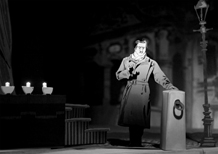
Walbrook inspired artwork by Matt McLaren
Double life of mysterious film star revealed in exhibition
A hugely popular film star in both Hitler’s Germany and in wartime Britain, actor Anton Walbrook was famous under two different names. Of Jewish heritage, and gay in an era when homosexuality was illegal he cultivated a mysterious image.
An exhibition of contemporary artworks inspired by the life and films of Walbrook is currently on display at the University of Exeter, Streatham Campus until the end of June.
The contemporary artwork exhibition also displays artefacts from the Bill Douglas Centre for the History of Cinema and Popular Culture, including early German cinema magazines and film stills.
Born Adolf Wohlbrück in Vienna, he achieved great success on both stage and screen in Germany during the 1920s and 1930s. Leaving Germany in 1936 to escape the Nazis, he became Anton Walbrook and arrived in Britain via Hollywood in 1937. He quickly won the hearts of British film goers with his portrayal of Prince Albert in two lavish biopics of Queen Victoria and his role in the hugely popular Dangerous Moonlight. Walbrook’s best work was done in partnership with Michael Powell and Emeric Pressburger, with whom he made four films between 1941 and 1955.
A remarkable series of over thirty pictures illustrating scenes from some of Walbrook’s best known films; including ‘Gaslight’ (1940), ‘The Life and Death of Colonel Blimp’ (1943) and ‘The Red Shoes’ (1948) feature in the exhibition. Artist Matt McLaren uses an unusual technique involving paper cut outs and miniature sets, which are then photographed. Alongside McLaren’s artwork, there are postcards, and film stills from the Bill Douglas collection which holds a wealth of material relating to Walbrook’s life and career.
James Downs was involved in putting the ‘ Star and Enigma’ exhibition together as a volunteer, some of his personal collection of Walbrook memorabilia will also be on display, including an original costume worn for his role as Prince Albert. Downs has also written and lectured on Walbrook and is currently writing the actor’s biography.
He said:”He is one of the most fascinating actors of the 20th century. Despite great popularity and a prolific career of some forty films, as well as theatre, radio and television work - he was an intensely private individual who kept much of his personal life hidden from view. His reticence created an aura of mystery and ‘otherness’ about him, which coloured both his acting performances and public perception of the man, reinforced in Britain by his German background.”
He added:“Although apparently somewhat aloof from the world around him, Walbrook had a strong screen presence and could convey a wide range of emotions through the subtlest of gestures. In these superb illustrations, Matt McLaren has succeeded as few artists could in capturing the strange, enigmatic qualities of Walbrook's personality as well as the forceful strength of character that made his performances so mesmerising to watch."
Walbrook’s post war career involved work for the theatre, film and television in France, Germany and Britain, including two films with director Max Ophuls. He died in Germany but in accordance with his wishes, his body was returned to England. Walbrook was buried near his home in Hampstead.
The ‘Star and Enigma’ exhibition is open to members of the public seven days a week and is free-of-charge. The exhibition is located in the foyer of the Old Library building, housing The Bill Douglas Centre, on the University of Exeter’s Streatham Campus.
Date: 14 March 2013
